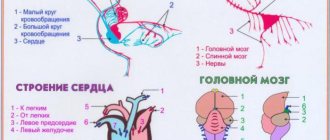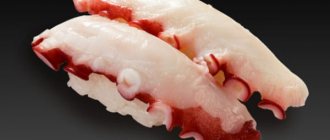Of course, fish and other aquatic inhabitants have a heart that has similar features to a human, performing its main function of supplying the body with blood. Unlike the human circulatory system, fish have only one circle and it is closed. In simple cartilaginous fish, the blood flow occurs in straight lines, while in higher cartilaginous fish it flows in the shape of the English letter S. This difference is due to the more complex structure of the organs of the circulatory system and the different composition of the blood. At the beginning of the article, we will look at the heart of simple fish, and after that we will move on to the amazing cartilaginous inhabitants of the aquatic world.
Evolutionary development
According to research by biologists, it was in fish that for the first time among all living organisms the heart appeared as a full-fledged functioning organ. The skullless had only a pulsating vessel, the lancelets also lacked a heart, but the circulatory system itself became closed.
Today, such a development can be seen at the stage of ontogenesis, because fish embryos have only a vessel, which by the end of the incubation period is transformed into the heart muscle.
The circulatory system of the fish became closed, that is, from then on, the blood moved exclusively through the vessels, and the heart was divided into two chambers, equipped with a valve apparatus and a cardiac sac. This moment became the most important intermediate stage in the further development of the evolutionary chain.
After a while, animals began to go out onto land, and then they needed a more complex organ associated with pulmonary respiration.
Even in ancient times, lobe-finned fish acquired an additional respiratory organ, in which the main role is played by swim bladders, an incomplete cardiac septum and the second circle of blood circulation. Researchers have identified the rudiments of the third cardiac chamber in their structure. Some representatives of this unique group live on Earth today.
The neighbors of fish in their habitat - cephalopods - developed a gill heart millions of years ago. These are special extensions that create a pulsation along the path of the gill veins, through which venous blood flows. The number of such hearts always corresponds to the number of gills. Octopuses, cuttlefish and squids have two, while nautiluses have four.
Structure
Considering the breathing patterns of fish and the presence of gills, the heart is structured differently than that of land animals. Visually, the shape of a fish’s heart is similar to ours. A small red sac, with a small pale pink sac underneath, is this organ.
The heart of cold-blooded aquatic inhabitants has only two chambers. Namely the ventricle and atrium. They are located in close proximity, or to be more precise, one above the other. The ventricle is located under the atrium and has a lighter shade. Fish have a heart consisting of muscle tissue, this is due to the fact that it acts as a pump and continuously contracts.
How many chambers do fish have in their heart?
The structure of the heart in fish includes two chambers. The first is a thin-walled atrium. It is in this section that the blood enters first. It is then pushed into the second chamber, which acts as a thick-walled ventricle. It is driven by the venous sinus (a sac with thin muscular walls) and the aortic cone (a pulsating muscular part with valves on the inner surface). Sometimes they are conventionally called the third and fourth chambers, which, of course, does not make the heart of fish similar to mammals and birds.
The four listed elements are located nonlinearly in the body of underwater animals: they form an S-shaped formation, where the aorta and ventricle are located below, and the vein and atrium are located above.
This is interesting: Fish have a very small heart: on average it occupies only 1%, while in mammals the volume reaches 4.7%, and in birds up to 16%.
Where is the heart?
If anyone is concerned about the question of how many hearts a fish has, we will immediately answer - one. It’s surprising that this question can arise at all, but as practice shows, it can. Very often, when cleaning fish, housewives do not even suspect that they can easily find the heart. Like humans, the heart of fish is located in the anterior part of the body. To be more precise, right under the gills. The heart is protected on both sides by ribs, just like ours. In the picture you see below, the main organ of fish is designated number one.
What kind of blood is in the heart of a fish?
Venous and arterial blood flows in the body of representatives of ichthyofauna. Having given oxygen to the organs, venous blood flows through the liver to the heart, and from there to the gill filaments to again be saturated with vital gas. Oxygen-enriched blood is called arterial - it is the blood that goes into the dorsal aorta and from there it spreads through small vessels to other organs.
This is interesting: at the moment, fourteen blood groups have been identified in fish.
The color of arterial blood in fish is bright red, venous blood is dark cherry. The hue is given by red blood cells that have an oval shape (unlike the human disc-shaped one) and a nucleus. In addition to them, the blood contains:
- Plasma is a colorless liquid that carries blood cells;
- Hemoglobin is a protein that carries oxygen in red blood cells;
- Leukocytes are white cells that protect the body from pathogens and assist in the digestive system of fish;
- Platelets are cells that ensure the integrity of blood vessels by coagulating fluid;
In general, the chemical composition of the blood of fish is not very different from that of vertebrates: it includes organic and inorganic elements and metabolic products. But the percentage of the ratio of liquid tissue to the mass of fish among living beings is the smallest - from 2 to 7%.
A wide range of organs can create blood: gills, intestinal mucosa, kidneys, spleen, lymphoid organ located in the skull, and the heart of the fish. The role of an intermediary between blood and tissues in the body of fish is played by the lymphatic system - a set of vessels with a clear liquid (lymph).
Organ size
The size of the heart depends on the total body weight, so the larger the fish, the larger its “motor”. Our heart is compared to the size of a fist; fish do not have this opportunity. But as you know from biology lessons, small fish have a heart only a few centimeters in size. But in large representatives of the underwater world, the organ can reach even twenty to thirty centimeters. Such fish include catfish, pike, carp, sturgeon and others.
Mechanism of blood circulation
Compared to humans, fish have a very simple circulatory system, which consists of five main elements:
- Hearts with two chambers;
- Abdominal aorta;
- Dorsal aorta;
- Arteries and capillaries;
- Ven;
This is interesting: bony fish have no valves in their chambers, while the heart of cartilaginous fish (sharks and rays) has quite a lot of them. Thanks to them, animals do not experience strong pulse pressure, which can damage thin-walled gills.
What have we learned?
In a biology report for grade 7, it is important to tell what type of circulatory system is typical for fish. In short, fish were the first animals to develop a full two-chambered heart. It is quite weak, but ensures the continuous movement of blood through one closed circle of blood circulation, saturating organs and tissues with oxygen and getting rid of carbon dioxide and metabolic products.
Previous
BiologyVegetative propagation of plants by stem and leaf cuttings - types, methods and examples briefly (grade 6, biology)
Next
Biology Digestive system of reptiles - structural features of internal organs and functions briefly (grade 7, biology)
Direction of blood circulation
Liquid tissue is transported through the circulatory system in only one direction - starting from the sinus venosus and ending with the conus arteriosus. One-way flow is ensured by valves that separate the chambers of the fish's heart.
In bony fish, which includes most species, venous blood that is not enriched, but cleared of toxins, flows through the aortic bulb into the abdominal aorta. Then it passes through four special channels - the afferent arteries - into the gills, where gas exchange occurs: oxygen penetrates into the blood, and carbon dioxide enters the environment.
From the efferent gill arteries, liquid tissue enters the epibranchial vessels: they form the head circle along the bottom of the skull and supply the brain of fish and other important organs of the head with substances. Next, the vessels form the dorsal aorta, located under the spine: smaller arteries and capillaries depart from it, which carry oxygen to the internal organs, muscles, and skin. From there, the blood returns through the capillaries to the veins.
The cardinal veins lead to the heart, where their ends join to form the ducts of Cuvier, which enter the sinus venosus, part of the heart muscle. The anterior vein carries current from the head organs of the nervous system of fish. The tail vein arises from the back of the body: it runs in the hemal canal directly below the artery.
In the area of the kidneys, this vein divides into a pair of portal veins. After filtration, the blood travels through the posterior cardinal veins to the heart, capturing red blood cells from the reproductive system along the way. All currents flow into the venous sinus, so that from there they can again begin pumping to the gills. Toxins are removed from the kidneys through the excretory system of fish.
In addition to the kidneys, the liver filters blood in the fish’s body. The portal veins of the liver take fluid tissue from the gastrointestinal tract, spleen and digestive glands, as well as a special organ - the swim bladder. Already purified blood exits through the capillaries into the paired hepatic veins and moves towards the heart.
This is interesting: in some fish (for example, perch, carp and pike), the right renal portal vein is underdeveloped, so the organ cannot fully perform the cleaning function.
There are species that have significant deviations in the structure of the system. Thus, in cyclostomes, instead of a pair of four, seven afferent and efferent arteries, an unpaired epibranchial vessel, and the renal portal system and Cuvier’s ducts are completely absent. There is only one vein in the liver.
Cartilaginous animals have five afferent arteries in the gills, and efferent arteries - twice as many. In addition to those listed, they have subclavian vessels supplying the pectoral fins and brachial muscles, and lateral vessels in the abdominal cavity.
The already mentioned lungfishes have a special structure. Oxygenated blood is concentrated in the left side of the heart, and from there, through a pair of gill arteries, it enters the fish’s brain, head organs and dorsal aorta. The venous one, concentrated in the right half, leaves through a pair of posterior arteries and flows through the gills into the “lungs” - swim bladders.
When these animals breathe on the surface of the water, the blood is saturated in the air sacs and goes through the pulmonary veins to the left chambers. Additionally, abdominal and cutaneous veins were formed in the body of lungfish.
Important: capillaries are microscopic vessels that, thanks to their thin walls, transfer nutrients and oxygen to organ cells as quickly as possible. The intermediate part between capillaries and veins is called venules.
Aqualover
Cold-blooded (body temperature depends on the ambient temperature) animals, fish , have a closed circulatory system, represented by the heart and blood vessels. Unlike higher animals, fish have one circulation (with the exception of lungfishes and lobe-finned fish).
The heart of fish is two-chambered: it consists of the atrium, ventricle, sinus venosus and conus arteriosus, which alternately contract with their muscular walls. Contracting rhythmically, it moves the blood in a vicious circle.
Compared to land animals, the heart of fish is very small and weak. Its mass usually does not exceed 0.33–2.5%, on average 1% of body weight, while in mammals it reaches 4.6%, and in birds - 10–16%. Blood pressure in fish is also weak. Fish also have a low heart rate: 18–30 beats per minute, but at low temperatures it can decrease to 1–2; In fish that survive freezing into ice in winter, the heart pulsation stops altogether during this period. In addition, fish have a small amount of blood compared to higher animals.
But all this is explained by the horizontal position of the fish in the environment (there is no need to push the blood upward), as well as by the life of the fish in water: in an environment in which the force of gravity affects much less than in the air.
Blood flows from the heart through arteries, and to the heart through veins.
From the atrium it is pushed into the ventricle, then into the conus arteriosus, and then into the large abdominal aorta and reaches the gills, where gas exchange occurs: the blood in the gills is enriched with oxygen and freed from carbon dioxide. The red blood cells of fish - erythrocytes - contain hemoglobin, which binds oxygen in the gills, and carbon dioxide in organs and tissues. The ability of hemoglobin in the blood of fish to extract oxygen varies among species. Fast-swimming fish that live in oxygen-rich running waters have hemoglobin cells that have a great ability to bind oxygen.
Oxygen-rich arterial blood has a bright scarlet color.
After the gills, the blood enters the head through the arteries and further into the dorsal aorta. Passing through the dorsal aorta, blood delivers oxygen to the organs and muscles of the trunk and tail. The dorsal aorta stretches to the end of the tail, from which large vessels extend to the internal organs along the way.
The venous blood of fish, depleted of oxygen and saturated with carbon dioxide, has a dark cherry color.
Having given oxygen to the organs and collected carbon dioxide, the blood flows through large veins to the heart and atrium.
The fish body also has its own characteristics in hematopoiesis:
Many organs can form blood: gill apparatus, intestines (mucous membrane), heart (epithelial layer and vascular endothelium), kidneys, spleen, vascular blood, lymphoid organ (accumulations of hematopoietic tissue - reticular syncytium - under the roof of the skull). The peripheral blood of fish may contain mature and young red blood cells. Red blood cells, unlike mammalian blood, have a nucleus.
The blood of a fish has an internal osmotic pressure.
To date, 14 fish blood group systems have been established.
When conducting a parasitological study of fish, blood, as well as circulatory organs, are taken for analysis.
Heart rhythm
Contraction of the heart muscle occurs at a certain frequency, the speed of which depends on many factors:
- Biological characteristics of the species;
- Age;
- Health conditions;
- Ambient temperatures;
- Breathing movements;
Thus, in adult carp, the heart rate is on average 20-35 beats per minute, which is quite slow for fish. Especially in comparison with juvenile sturgeon, whose heart rate reaches 150 beats.
The most significant factor is temperature. As soon as the water gets colder, the fish’s heart begins to beat more and more slowly. During hibernation, a bream's heart beats to one beat per minute.
The main task of heart rate is to maintain a certain volume of blood flow corresponding to internal and external circumstances.
Work of the organ
The functioning of the fish heart mainly depends on two factors: heart rate and stroke volume. With each heartbeat, the ventricle pumps out blood. The volume is called stroke volume and the timing of the heart rhythm is known as heart rate.
The atrium of the fish is filled with suction created by the rigidity of the pericardium and surrounding tissue. Venous blood returning to the atrium is accompanied by ventricular contraction in systole, which causes a drop in intrapercardial pressure, which is transmitted through the thin atrium wall to create an aspiration or font effect .
Fish have a circulatory system in which blood passes through the heart only once during each complete cycle. Deprived of oxygen, it reaches the heart from the body tissues, from where it is pumped into the gills.
Gaseous exchange occurs within the gills, and oxygenated blood from the gills circulates throughout the body.
How does the systemic and pulmonary circulation work?
It consists of two successively connected circles (loops), starting from the ventricles of the heart and flowing into the atria: the systemic circulation begins in the left ventricle and ends in the right atrium; The pulmonary circulation begins in the right ventricle and ends in the left atrium.
Interesting materials:
How did Sharikov become a dog again? How to polish stones? How to use VK from two accounts on one browser? How to sync two Sony speakers? How to say arividerchi? How to send a video from YouTube to WhatsApp? How to copy from Excel to Excel? How to copy an artboard? How to copy a Yandex disk link? How to copy a link to a YouTube video on an iPhone?











